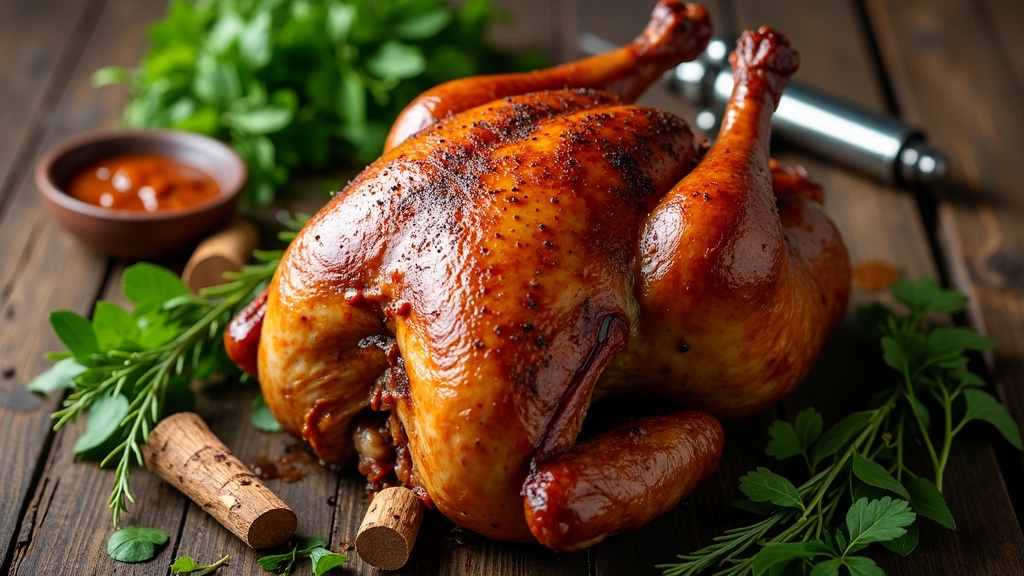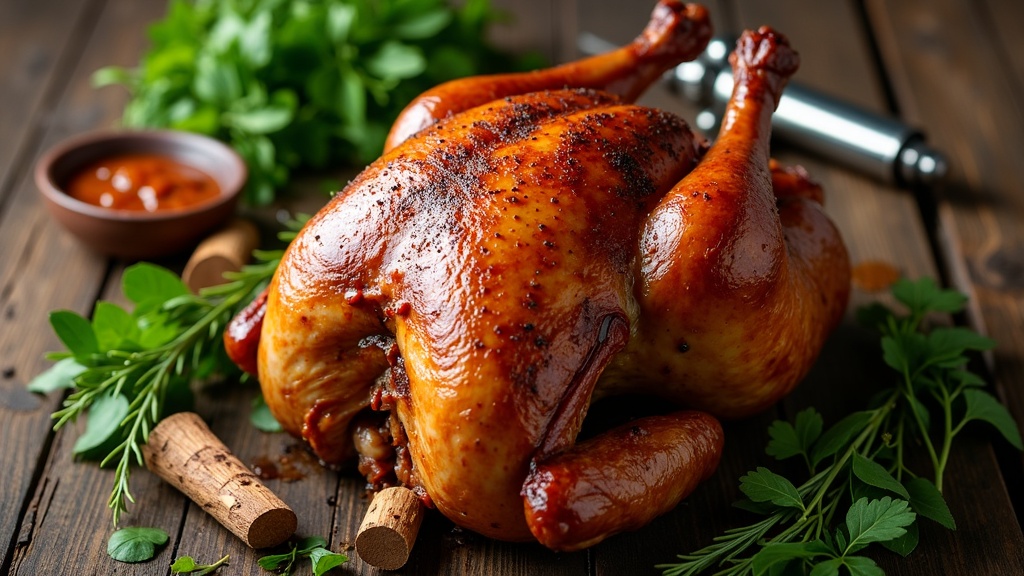Injecting your turkey before smoking it sparks plenty of debate in the BBQ world. Some cooks swear by this step for a juicier, tastier bird, while others think it might be overkill. Ultimately, it comes down to your personal taste, what kind of smoking setup you have, and how much extra effort you want to put in. In this guide, I’ll walk you through all the details, so by the end, you’ll have a clear idea if injecting is right for your next smoked turkey.

Why People Inject Turkeys Before Smoking
Injecting lets you get flavor and moisture deep inside the meat—well beyond what brining or rubbing the surface achieves. Instead of just seasoning the outside, injection lets you push herbs, melted butter, broth, and other tasty goodies straight into the turkey breasts and legs, which can benefit from a little extra moisture and flavor.
Most folks inject to spread flavor more evenly. Turkey, especially the breast, can go dry during long smoking sessions. With the slow pace of smoking, it’s easy to lose moisture. An injection helps keep juices locked inside and brings big flavor to every bite.
I’ve cooked injected and noninjected turkeys side by side. That boost in juiciness and taste is hard to miss, especially when you revisit the leftovers. If you’re aiming to wow your guests or shake up the classic approach, injecting is worth a shot—it’s a great way to set your turkey apart from the pack.
The Science Behind Injecting Meat
So what’s happening when you inject turkey? You’re using a needle to send marinade right into those thick muscle areas, speeding up the process of getting flavor deep inside. Broth, melted butter, garlic, or even fruit juices slowly work their way into the meat fibers as the turkey cooks.
During smoking, the injected mixture spreads out and partly steams inside the meat. Adding butter or oil helps keep things moist by replacing some of the fat that will melt away. Salt in the mix can also help break down the proteins a bit, making each bite more tender.
While most research centers on pork and beef, the logic holds for turkey too: muscle fibers help spread that injection throughout the meat, making every bite well-seasoned and juicy. If you’ve had dry turkey before, injection can definitely help flip the script.
Traditional Methods vs. Injection: What’s the Difference?
Traditional ways to prep turkey mean either dry brining (just salt, let it hang out in the fridge) or wet brining (soaking in a saltwater bath). Both work nicely, but injection brings something fresh to the table.
- Brining: Covers the bird all over, but takes up lots of fridge room and doesn’t infuse deep flavor.
- Dry Rubs: Great for building bold flavor on the skin, but stay close to the surface.
- Injection: Gives both flavor and moisture straight inside where it counts. Even better, it’s fast—usually takes just 10 to 15 minutes to finish up.
My recommendation: brine to get a subtle overall boost of salt and moisture, then inject if you want bold flavor and extra juiciness, especially in the white meat. Using both isn’t too much, just go easy on the salt so it doesn’t overload the turkey.
How to Inject a Turkey: Simple Steps and Tips
Injecting isn’t tricky, but a few helpful tips can make your turkey even better. First, grab a meatsafe injector (they’re easy to find and affordable). Next, make your injection mixture—think low sodium broth, melted butter, garlic, herbs, a splash of citrus, or hot sauce for some extra punch.
- Mix Everything: Keep your injection smooth. Strain out herbs or spices that might clog your injector.
- Fill and Inject: Draw your mixture into the syringe. Stick the needle deep into the largest parts—breasts, thighs, drumsticks. Inject slowly as you draw the needle out. This helps spread out the flavor.
- Move Around: Go around the bird hitting multiple spots, aiming for even coverage; this stops flavor pockets.
- Don’t Overload: Too much liquid can cause weird wet spots or leaks. Use about 1 to 2 ounces per pound of turkey for balance.
Let the turkey rest for an hour after injecting before it meets the smoker. This allows flavors to distribute and prevents those “wet” patches under the skin.
Popular Injecting Mixtures for Smoked Turkey
One awesome thing about injection is how flexible you can be with flavors. Here are some go-to combos:
- Classic Butter Garlic: Melted butter, chicken broth, strained minced garlic, a squeeze of lemon juice, and salt.
- Cajun Style: Butter, hot sauce, Cajun seasoning, and chicken stock—a spicy twist.
- Herb Citrus: Olive oil, lemon zest, thyme, rosemary, garlic powder, salt, and pepper.
- Apple Sage: Apple juice, fresh sage, melted butter, a pinch of brown sugar, and some salt.
Just keep your blend smooth and strain out any chunky bits to avoid blockage. Always taste your mixture before using it so you know what’s going into your turkey.
Pros and Cons of Injecting Your Turkey
- Pros:
- Insanely juicy, especially perfect for white meat
- Deep, rich flavor throughout every slice
- Easily personalize your turkey flavor
- Great for longer smoking sessions where dryness is a risk
- Cons:
- Risk of uneven “wet” patches if too much is injected in one place
- Can make meat taste a bit processed if using storebought blends
- Involves extra tools and clean-up
- Some folks like the basic turkey flavor best
If extra flavor and preventing dry turkey matter to you, injection is a solid move. On the other hand, if you love super crispy skin or want a truly traditional meal, you may be better off skipping it—sometimes, simple is best.
When Should You Inject (and When Not To)?
Consider injection if:
- You want a unique or bold flavor (perfect for special events or curious cooks)
- You’re worried about dry turkey breast or overcooking
- Your turkey is big (over 12 pounds) and needs a moisture boost
- You’re working with supermarket turkeys, which can be leaner than heritage breeds
When to skip injection:
- You’re already brining with a well-seasoned solution and cooking a smaller bird
- Super crispy skin is your top priority
- You like classic turkey flavor with minimal extras
Extra Tips for a Juicier Smoked Turkey
Injection helps, but it’s just one tool. Here are some bonus tips I don’t overlook:
- Brine Before: Even a six-hour brine can do wonders for flavor and juiciness.
- Cook to Temperature: Always cook to 160-165°F in the breast—never by the clock. Overcooking dries out the bird.
- Rest Before Carving: Let it rest for 20-30 minutes, so juices can soak back in and every bite is moist.
- Use Good Wood: Try apple, cherry, or pecan chunks; they give a mellow smoke boost without overpowering other flavors.
Put these in your routine, and you’ll be serving up juicy turkey, injection or no injection.
Common Problems and Simple Fixes
- Clogged Injector: Always strain your mix and rinse the needle in between injections.
- Puddles Under Skin: Inject less in each place and move the needle around more. Smaller injections in several spots prevent big puddles.
- Too Salty or Spicy: Use low or no salt broth and lighten up the injection’s seasoning if you brine or rub as well.
- Moist but Bland Meat: Sweeten up your mix, or throw in more herbs and garlic to build up flavor.
How to Tell if Injection Is Working
If your turkey is juicier than past attempts and every bite is seasoned all the way through—not just the edges—then you’ve nailed it. Leftovers should stay moist for days, making them perfect for sandwiches and salads.
What Pitmasters and Cooks Have Seen in the Field
Pro pitmasters often inject their birds, especially for competitions where every judge might only take one bite. That extra moisture and big flavor help set their turkey apart. Backyard cooks may skip it for simplicity or smaller groups, but once you try it, it’s easy to tell the difference—when you want flavor all the way inside, injection is tough to beat.
Comparing injected and noninjected turkeys proves it—the reheated leftovers from injected turkey don’t dry out. If you’re planning meals for a gathering or want droolworthy turkey sandwiches the next day, try this method and see how it steps up your cooking game.
FAQs About Injecting Turkey Before Smoking
Question: Can I still brine my turkey if I’m injecting it?
Answer: Yes, but make sure you stick to a low salt injection or brine so the turkey doesn’t end up over-seasoned and rubbery.
Question: Will injection work with other cooking methods?
Answer: Definitely! Roasting and deep frying also work with injection—just use a light touch to avoid splattering oil or soggy skin.
Question: What if I don’t have a meat injector?
Answer: You can grab an injector at most kitchen stores for cheap, but if you’re out of luck, focus on brining or rubbing for now. Injection is handy, but not essential.
Question: Is it safe to inject raw turkey?
Answer: As long as your tools, hands, and work area are clean, it’s totally safe. Make sure you clean up well after you’re done.
Question: How far ahead do I need to inject my turkey?
Answer: Anywhere from one to twenty-four hours is fine. Even an hour gives the flavors time to move through the bird.
Wrapping Up: Should You Inject Your Turkey Before Smoking?
Injecting a turkey before smoking it is a handy way to lock in moisture and flavor all the way to the bone. While it takes a little more time and mess, the payoff comes in juicy slices and a taste boost sure to impress. Whether you save injecting for holidays or add it to your regular BBQ routine, testing it out at least once is worth the effort—you might stumble upon your family’s new favorite turkey.
Smoked turkey is already next-level cool, but with injection, you can take it up a notch. Don’t be afraid to experiment. Try it on your next cookout and see if the extra steps turn your turkey from good to unforgettable.

